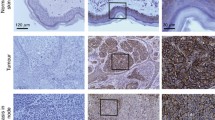Abstract
We investigated the role of signal transduction systems in the attachment of human uveal melanoma cells to matrix proteins. Ocular melanoma cells established from primary tumours attached rapidly to all substrates examined. Preferred substrates of attachment were collagens type I, III and IV and fibronectin rather than laminin, gelatin, arginine-glycine-aspartine, vitronectin, poly-I -lysine or plastic. All cells showed rapid attachment to the preferred substrates (80% within 10 min). Manipulation of intracellular cyclic AMP or protein kinase C activity had relatively little effect on cell attachment. In contrast, attachment was significantly reduced by manipulating either intracellular calcium or calmodulin. After 15 min at 37°C, the calcium ionophore ionomycin (5 μm) reduced attachment to 25%, and TMB8 (50 μM), which can reduce intracellular calcium, reduced attachment to 60%. The experimental calmodulin antagonist J8 (25 μm), a substituted naphthalene sulphonamide, reduced attachment to 40%. Similarly tamoxifen (25 μM), which has calmodulin antagonist activity in vitro,reduced attachment to 55%. Both J8 and tamoxifen inhibited cell attachment to a wide range of matrix proteins, suggesting that this effect on attachment is not dependent on the presence of specific adhesion receptors. Reduction of ocular melanoma tumour cell/matrix interactions through manipulation of intracellular calcium or calmodulin may therefore merit further investigation as a possible approach to reducing metastatic spread.
Similar content being viewed by others
References
Mortarini R and Anchini A, 1993, From adhesion to signalling: Roles of integrins in the biology of human melanoma.Melanoma Res,3, 87–97.
Woods A and Couchman JR, 1992, Protein kinase C involvement in focal adhesion formation.J Cell Sci,101, 277–90.
Mac Neil S, Wagner M, Wowk I,et al. 1992, Intracellular regulation of cell adhesion to extracellular matrix components in murine B16 melanoma cells of differing metastatic potential.Melanoma Res,2, 345–54.
Lam H-YP, 1984, Tamoxifen is a calmodulin antagonist in the activation of cAMP phosphodiesterase.Biochem Biophys Res Comm,118, 27–32.
Lopes MCF, Value MGP and Carvalho AP, 1990, Ca2+-dependent binding of tamoxifen to calmodulin isolated from bovine brain.Cancer Res,50, 2753–8.
Mac Neil S, Wagner M, Kirkham PR,et al. 1993, Inhibition of melanoma cell/matrix interaction by tamoxifen.Melanoma Res,3, 67–74.
Lien EA, Solheim E and Ueland PM, 1991, Distribution of tamoxifen and its metabolites in rat and human tissues during steady state treatment.Cancer Res,51, 4837–44.
Mac Neil S, Griffin M, Cooke AM,et al. 1988, Calmodulin antagonists of improved potency and specificity for use in the study of calmodulin biochemistry.Biochem Pharmacol,37, 1717–23.
Goodall T, Buffey JA, Rennie IG,et al. 1994, Effect of melanocyte stimulating hormone on human cultured choroidal melanocytes, uveal melanoma cells and retinal epithelial cells.Invest Ophthalmol Vis Sci,35, 826–37.
Ealey PA, Yateman ME, Holt SJ and Marshall NJ, 1988, ESTA: a bioassay system for the determination of the potencies of hormones and antibodies which mimic their action.J Mol Endocrinol,1, R1-R4.
Buffey JA, Hill SE, Bleehen SS, Thody AJ and MacNeil S, 1991, Evidence for a calcium/calmodulin involvement in density-dependent melanogenesis in murine B16 melanoma cells.Pigment Cell Res,4, 112–9.
Hynes RO, 1992, Integrins: versatility, modulation and signalling in cell adhesion.Cell,69, 11–25.
Woods A and Couchmann JR, 1988, Focal adhesions and cell/matrix interactions.Collagen Rel Res,8, 155–82.
Mac Neil S, Dawson RA, Crocker G,et al. 1993, Antiproliferative effects on keratinocytes of a range of clinically used drugs with calmodulin antagonist activity.Br J Dermatol,128, 143–50.
Wagner M, Benson MT, Rennie IG and Mac Neil S, 1994, Intracellular regulation of retinal pigment epithelial cell attachment to extracellular matrix proteins.Curr Eye Res, in press.
Barton CH, Blackburn GM, Rees R,et al. 1987, A comparative study of the antiproliferative effects of calmodulin antagonists in cultured cells-W7 derivatives of improved cytostatic potential.Carcinogenesis,8, 919–23.
Cocconi G, Bella M, Calabresi F,et al. 1992, Treatment of metastatic malignant melanoma with dacarbazine plus tamoxifen.N Engl J Med,327, 516–23.
Author information
Authors and Affiliations
Rights and permissions
About this article
Cite this article
Neil, S.M., Wagner, M. & Rennie, I.G. Investigation of the role of signal transduction in attachment of ocular melanoma cells to matrix proteins: inhibition of attachment by calmodulin antagonists including tamoxifen. Clin Exp Metast 12, 375–384 (1994). https://doi.org/10.1007/BF01755881
Received:
Accepted:
Issue Date:
DOI: https://doi.org/10.1007/BF01755881




